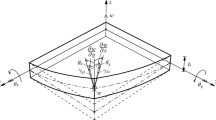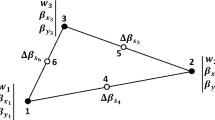Abstract
Many displacement-based quadrilateral plate elements based on Mindlin-Reissner plate theory have been proposed to analyze the thin and moderately thick plate problems. However, numerical inaccuracies of some elements appear since the presence of shear locking and spurious zero energy modes for thin plate problems. To overcome these shortcomings, we employ the large increment method (LIM) for the analyses of the plate bending problems, and propose a force-based 8-node quadrilateral plate (8NQP) element which is based on Mindlin-Reissner plate theory and has no extra spurious zero energy mode. Several benchmark plate bending problems are presented to illustrate the accuracy and convergence of the plate element by comparing with the analytical solutions and displacement-based plate elements. The results show that the 8-node plate element produces fast convergence and accurate stress distributions in both the moderately thick and thin plate bending problems. The plate element is insensitive to mesh distortion and it can avoid the shear locking for thin plate analysis.
Similar content being viewed by others
References
Zienkiewicz O C, Taylor R L, Too J M. Reduced integration technique in general analysis of plates and shells [J]. International Journal Numerical Methods in Engineering, 1971, 3(2): 275–290.
Hughes T J R, Cohen M, Haron M. Reduced and selective integration techniques in the finite element analysis of plates [J]. Nuclear Engineering and Design, 1978, 46(1): 203–222.
Hinton E, Huang H C. A family of quadrilateral Mindlin plate elements with substitute shear strain fields [J]. Computers and Structures, 1986, 23(3): 409–431.
Darilmaz K. An assumed-stress finite element for static and free vibration analysis of Reissner-Mindlin plates [J]. Structural Engineering and Mechanics, 2005, 19(2): 199–215.
Cheung Y K, Chen W J. Hybrid quadrilateral element based onMindlin/Reissner plate theory [J]. Computers and Structures, 1989, 32(2): 327–339.
Zhang H X, Kuang J S. Eight-node Reissner-Mindlin plate element based on boundary interpolation using Timoshenko beam function [J]. International Journal for Numerical Methods in Engineering, 2007, 69(7): 1345–1373.
Zhang C J, Liu X L. A large increment method for material nonlinearity problems [J]. Advances in Structural Engineering, 1997, 1(2): 99–109.
Long D B, Liu X L. Development of 2D hybrid equilibrium elements in large increment method [J]. Journal of Shanghai Jiaotong University (Science), 2013, 18(2): 205–215.
Jia Hong-xue, Long Dan-bing, Liu Xi-la. Application of large increment method in plate analysis [J]. Journal of Shanghai Jiaotong University, 2013, 47(2): 187–206 (in Chinese).
Barham W, Aref A J, Dargush G. Development of the large increment method for elastic perfectly plastic analysis of plane frame structures under monotonic loading [J]. International Journal of Solids and Structures, 2005, 42: 6586–6609.
Barham W, Aref A J, Dargush G F. On the elastoplastic cyclic analysis of plane beam structures using a flexibility-based finite element approach [J]. International Journal of Solids and Structures, 2008, 45: 5688–5704.
Wang Kai-jian. Network parallel computation based on the large increment method [D]. Beijing: Department of Civil Engineering, Tsinghua University, 2004 (in Chinese).
Ben-Israel A, Greville T N E. Generalized inverse: Theory and application [M]. New York: Wiley, 1974.
Dhananjaya H R, Pandey P C, Nagabhushanam J. New eight node serendipity quadrilateral plate bending element for thin and moderately thick plates using integrated force method [J]. Structural Engineering and Mechanics, 2009, 33(4): 485–502.
Timoshenko S, Woinowsk-Krieger S. Theory of plates and shells [M]. New York: McGraw-Hill, 1959.
Liu J, Riggs H R, Tessler A. A four node sheardeformable shell element developed via explicit Kirchhoff constraints [J]. International Journal Numerical Methods in Engineering, 2000, 49: 1065–1086.
Morley L S D. Skew plates and structures, series of monographs in aeronautics and astronautics [M]. New York: MacMillan, 1963.
Ayad R, Rigolot A. An improved four-node hybridmixed element based upon Mindlin’s plate theory [J]. International Journal for Numerical Methods in Engineering, 2002, 55: 705–731.
Wang Shou-mei, Liu Zhi-yong. The essence and elimination of shear locking [J]. Acta Aeronautica et Astronautica Sinica, 1989, 10(1): 74–78 (in Chinese).
Author information
Authors and Affiliations
Corresponding author
Additional information
Foundation item: the National Natural Science Foundation of China (No. 10872128)
Rights and permissions
About this article
Cite this article
Jia, Hx., Long, Db. & Liu, Xl. Development of the large increment method in analysis for thin and moderately thick plates. J. Shanghai Jiaotong Univ. (Sci.) 19, 265–273 (2014). https://doi.org/10.1007/s12204-014-1498-2
Received:
Published:
Issue Date:
DOI: https://doi.org/10.1007/s12204-014-1498-2
Key words
- displacement-based quadrilateral plate element
- Mindlin-Reissner plate theory
- shear locking
- spurious zero energy modes
- large increment method (LIM)




